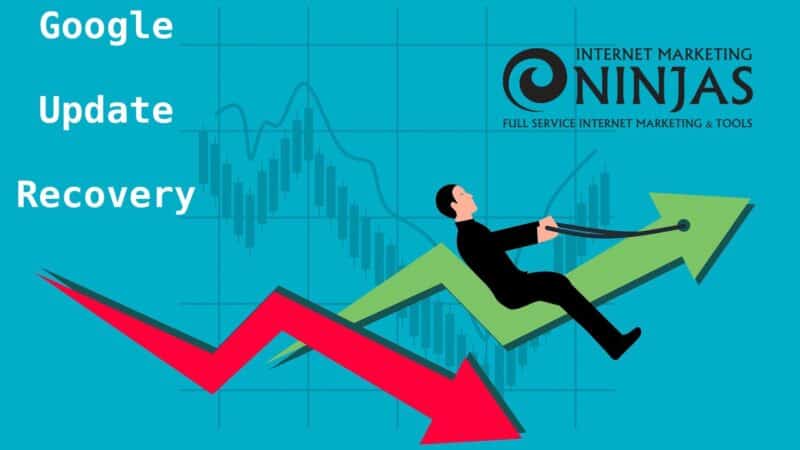A tale of two recoveries by Internet Marketing Ninjas

“It was the best of times; it was the worst of times,” as the famous Dickens line goes.
Being negatively affected by a Google algorithm update can quickly bring website traffic and SEO performance from all-time highs to all-time lows.
Google’s March 2023 core update finished rolling out at the end of last month, leading to significant SERP shakeups in various verticals, causing many webmasters to lose significant organic traffic in a very short time.
As an SEO agency specializing in ranking drop solutions, we’d love for each client to come out on top after every Google update. Realistically, that’s not always the case – but the insight and advice we’re able to provide to clients throughout “the worst of times” is often some of the most valuable work we provide.
Naturally, humans often delay preventative efforts until there’s an actual problem and only then begin looking for the “quick fix.”
When a site is negatively affected by a core update, Google’s stance has been “You’ve done nothing wrong, you’re not penalized, there’s nothing to fix, and continue to make your website and webpages the best they can be.”
Not very helpful, right?
In reality, fundamental SEO efforts can increase the likelihood you’ll come out on top after an update – even if only because you’re a small step ahead of what your competitors are (or aren’t) doing when it comes to optimization efforts.
As Google continues to roll out its algorithm updates every few months (the ones they tell us about, at least), let’s look at two recoveries we saw last month for websites previously affected by the prior core update in September of 2022.
Before that, here are two quick notes:
- Google’s core updates often roll out over a few weeks, so it’s important to wait for the update to complete before assessing the impact on your site. It’s rather common for a site to sharply increase or decrease visibility early in the update process, only to reverse course (or normalize) at the end of the update.
- It’s also important to ensure there were no other major initiatives that may have affected traffic during this time. Significant efforts like migrations, re-launches, indexation changes, URL rewrites and so on can significantly affect SEO visibility during an update like they can at any other time.
Site 1: The kitchen sink approach
The first site we’ll look at is an affiliate site, publishing a lot of unique content in their field regularly. As the site grew, so did traffic – up until the September 2022 core update, where it began losing about 50% of its SEO visibility.
To combat this, we worked with the site owner to take a “kitchen sink” approach to recovery. That is, looking at and improving SEO elements from top to bottom, throwing everything we could at the site to encourage it to regain lost traffic.
This is an extensive (and expensive) path to take, especially when a site is not producing revenue like it once was.
However, the kitchen sink approach often leads to the best and longest-lasting results. Ideally, you’re giving Google what it needs to not only help you recover the lost traffic lost due to an update but improving everything to the point that Google trusts and ranks your site more consistently in the long term.
The following efforts were taken for this site over three months:
- Tidying up any technical SEO errors & mishaps we uncovered during a fresh crawl of the site.
- Removing, archiving, or de-indexing select content deemed no longer relevant from years past.
- Updating much of the remaining content to make it more timely, relevant and useful in 2023. Also, reviewing this content for basic keyword optimization & relevancy and improving accordingly.
- Filling content gaps identified when compared to other top-ranking competitors.
- Updating sitemaps to account for page removals and additions.
- Providing multiple vendors to buy the advertised affiliate products from rather than just one option, highlighting the pros and cons of each product to provide more comprehensive insight.
- Integrating authorship on pages where it lacked, creating robust about & contact pages, including testimonials & references throughout the site, and focusing on other E-E-A-T signals.
- Maximizing schema opportunities across the site.
- Optimizing the site’s internal linking structure to give the remaining pages more internal links.
- (Finally) taking the time to improve site speed and Core Web Vitals, an effort that had been deprioritized up to this point. With this, some light design edits were based on our team’s UX feedback to further enhance the overall visitor experience.
- Conservatively disavowing a few dozen questionable links from known link sellers – links we knew provided no value but felt it was a good time to fully dissociate from them.
- Building new trusted links and earning new media coverage for the domain, the continuation of an existing effort.
While there were some incremental improvements throughout, the results paid off during last month’s March 2023 core update. The site regained 88% of the traffic it lost during the prior update in late 2022 and is on an upwards trajectory as of this writing.
A further indication of success: even though 100%+ of the traffic didn’t come back, the site’s rankings fully recovered or even improved in some cases. Unfortunately, Google’s SERPs continue to become more crowded with ads, shopping results, SERP features and now AI integration, reducing organic click-through rates… but that’s a topic for another day.
Site 2: The “wait and see” approach
The second site offers specialized insurance products. Like Site 1, their traffic grew until the September 2022 core update caused them to see a nearly 50% reduction in organic SEO traffic.
As previously mentioned, it is often difficult to allocate additional resources when revenue from the SEO channel is declining. This is especially true for small and mid-market business owners. As such, this client made the difficult decision to put SEO efforts aside and focus on paid media and other forms of lead generation to keep their business going.
Site 2’s story is one without much of a plot: from an SEO perspective, no new work was done on the site. No on-page improvements, no off-page link building. Zero. The site continued to exist just as it was last fall.
Fast forward to the March 2023 core update; voila, the site fully recovered to previous levels. Its SEO visibility is back to where it was before the last update, almost as if Google undid whatever caused the site to lose rankings in the first place.
But what does this tell us about Google? How can consecutive core algorithm updates have opposite effects on a website’s SEO performance when nothing with the website changes?
These are all fair questions and another reminder that while we can influence the outcomes and success of our efforts, we’re never fully in control of them when it comes to visibility in organic search. It’s also why as SEOs, our work remains so important in an ever-changing industry.
Preparation is key
For Site 2, the good news is the site is starting to produce new leads, and the business owner is cautiously excited about SEO again.
The not-so-good news is that while we’re encouraged by the recovery, we’re less optimistic about the site’s long-term success when compared to Site 1 and the efforts put into making it the best it can be.
The more SEO elements you can get “right” consistently (especially when compared to top-ranking competitors, who may or may not be your actual business competition), the better prepared you will be to weather the storm should you ever find yourself experiencing the “worst of times.”
Over the years, we’ve consistently seen sites that think long-term, stay on top of best practices and ahead of the competition and dedicate resources towards an experienced SEO team perform better throughout Google updates. Even if negatively affected, they experience smaller traffic drops and quicker recoveries.
Preparation and prevention efforts are worth saving the time and expense of experiencing a downturn from an update. While it’s impossible to guarantee you’ll always escape an algorithm change unharmed, you’ll be in a much better position to experience the “best of times” long-term.
The post A tale of two recoveries appeared first on Search Engine Land.






Recent Comments